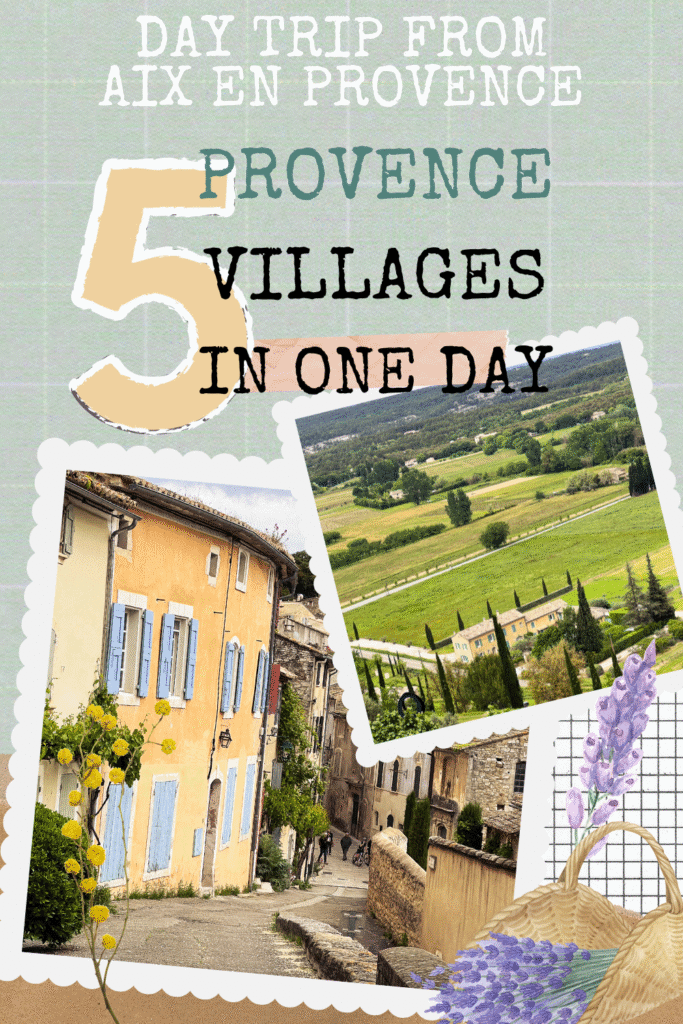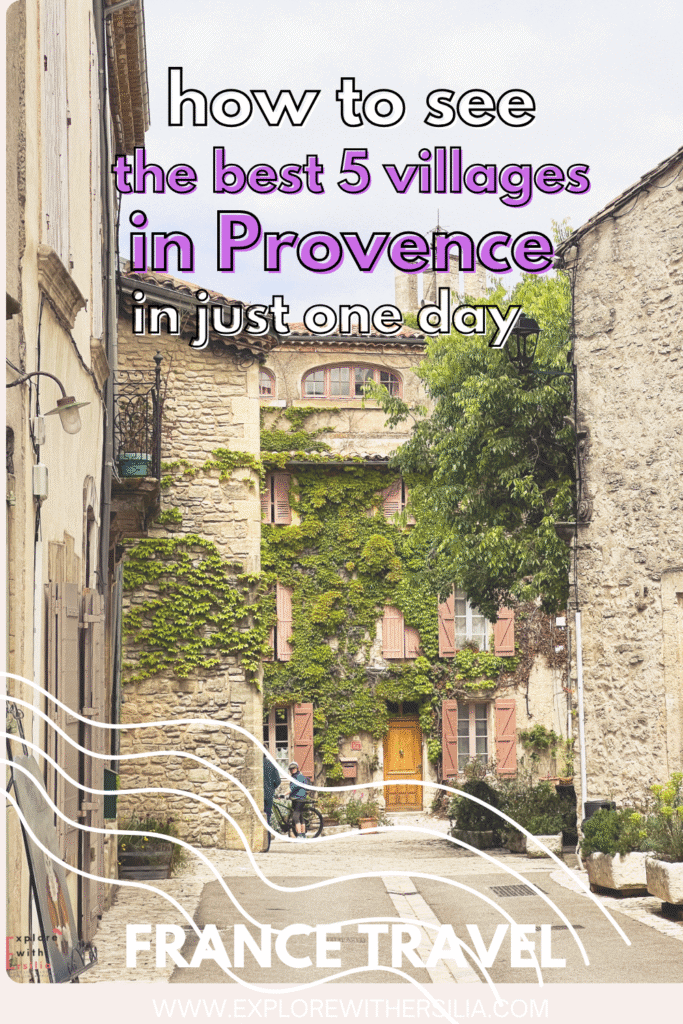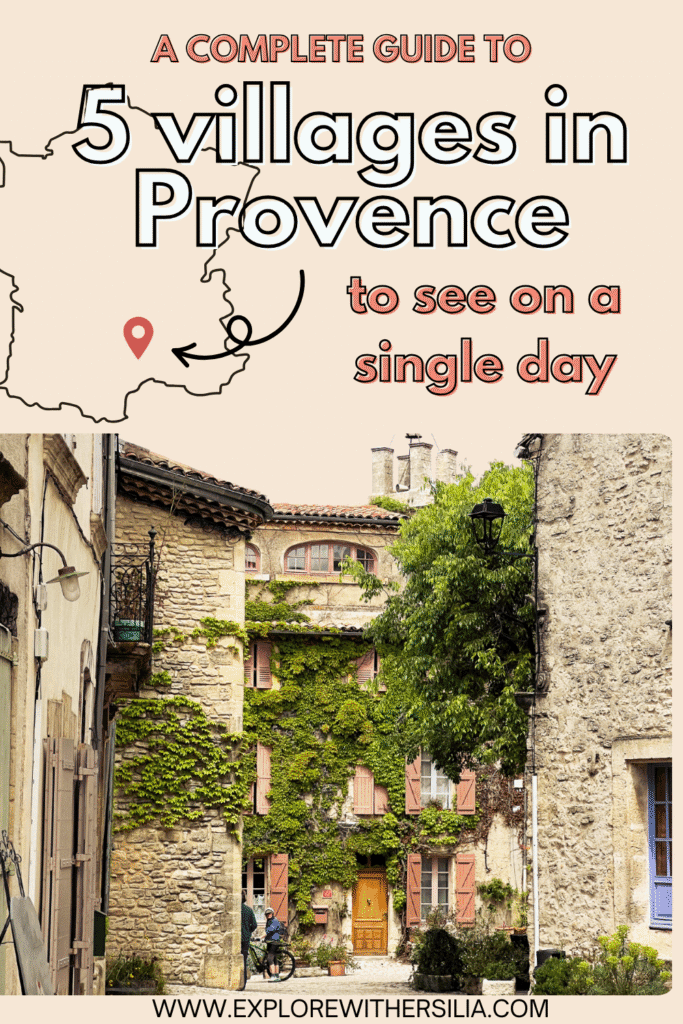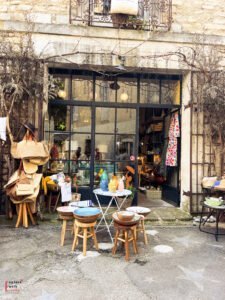Explore with Ersilia contains affiliate links and is a member of the Amazon Services LLC Associates Program. If you make a purchase using one of these links, I may receive compensation at no extra cost to you. affiliate links are how we keep this content free. A huge thanks if you use these as it helps a lot! See the Full Policy for more information.
Why a Village-Hopping Day in Provence Should Be on Your Bucket List
When I planned my trip to Provence, I knew I wanted to experience those picture-perfect hilltop villages I’d seen in countless photos.
But with limited time and so many options, how would I choose? The answer was simple: I wouldn’t choose just one. Instead, I mapped out the ultimate day trip from Aix-en-Provence that would take me through five of the region’s most captivating villages.
I love this itinerary because you can include it either on a longer stay in Provence, or during your French Riviera trip. You can either start in Aix-en-Provence, or choose to stay somewhere closer, like Saint-Remy, Avignon or Orange.
This carefully planned route through Saignon, Roussillon, Gordes, Ménerbes, and Lacoste delivers a perfect sampler of what makes the Luberon region so special.
From rustic charm to panoramic vistas, from ochre cliffs to medieval stone, each village offers something unique while still feeling quintessentially Provençal.
Let me share with you exactly how I did it, what made each stop special, and how you can recreate this magical day for yourself.
Getting Started: Practical Tips for Your Provence Village Tour
Before diving into the villages themselves, let’s talk logistics.
This day trip requires an early start—I left Aix-en-Provence at 8:00 AM to give myself enough time to truly experience each location without rushing.
The complete loop covers about 200 kilometers, including the return to Aix.
Car Rental and Driving in Provence
A car is absolutely essential for this day trip. You should rent it the day before, which gives you flexibility in departure time. I recommend reserving in advance, especially during the busy summer months.
Personal tip: Opt for a compact car rather than something larger, it will make navigating the narrow village streets much easier. The roads between these villages are generally well-maintained but can get very narrow if you ride through the villages.
Driving in Provence is relatively straightforward, but keep a few things in mind:
- The roads between villages are scenic but can be slow-going
- GPS is helpful but sometimes loses signal in remote areas
- Parking in these small villages can be challenging, especially in high season. Come with an open mide and don’t be afraid of some extra steps ! (We did around 26 000 steps on this day trip, by the way)
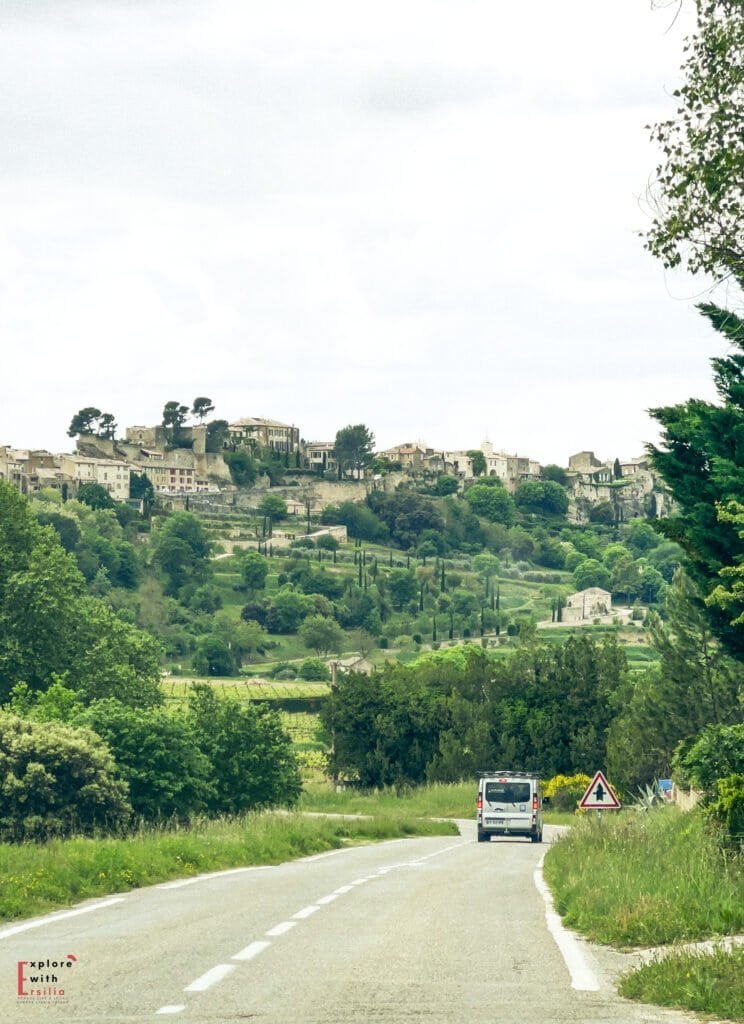
What to Bring
My day bag essentials included:
- Water bottle (refilled in village fountains)
- Comfortable walking shoes (those cobblestone streets are charming but uneven)
- Hat and sunscreen (Provençal sun is stronger than you might expect)
- Small amount of cash for village markets that don’t accept cards
- Camera (you’ll want to capture everything!)
Now, let’s embark on our village-hopping adventure!
Stop 1: Saignon – The Hidden Gem of Provence
Driving time from Aix-en-Provence: About 1 hour 15 minutes
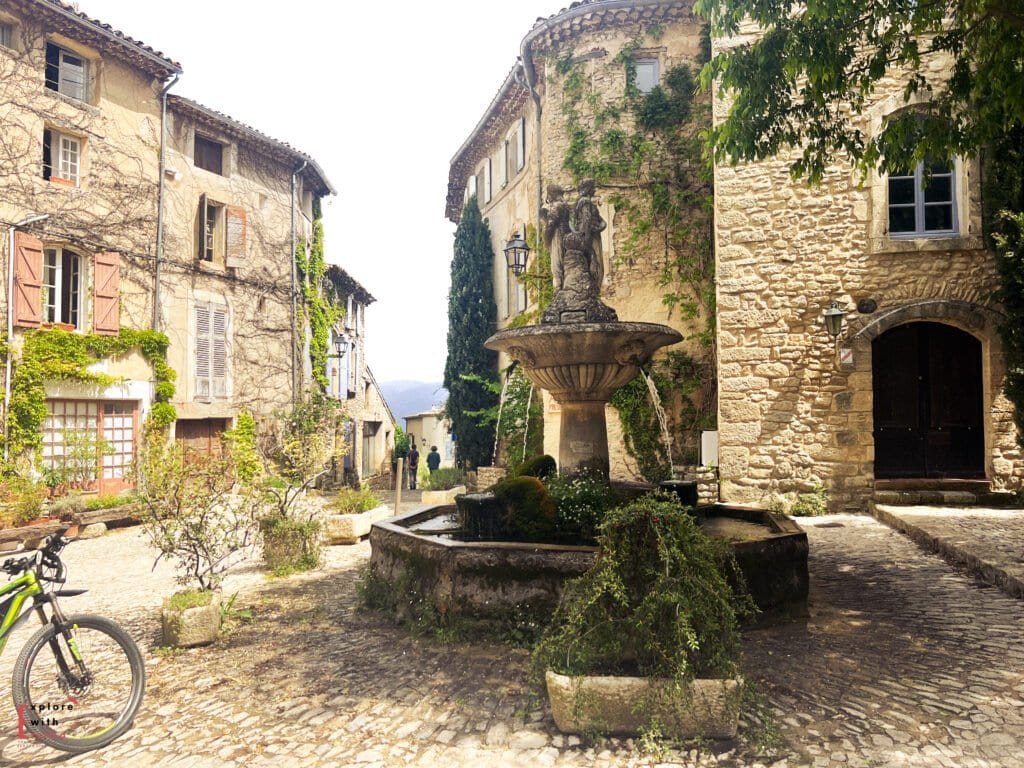
When I arrived in Saignon around 9:30 AM, I immediately understood why this village remains something of a secret compared to its more famous neighbors.
Perched on a rocky outcrop above Apt, this unassuming village captured my heart with its authentic charm and lack of pretension.
What makes Saignon special is precisely what it doesn’t have—crowds, souvenir shops, or a feeling of being in a tourist attraction rather than a living village.
Here, locals still predominate, and the rhythm of daily life continues much as it has for generations.
I was there in early May during a national holiday week in France, and there were around 20 persons in the whole village!
What to See in Saignon
The first thing I noticed was the massive rock formation (Le Rocher) that dominates the village. A short climb to the top rewarded me with breathtaking panoramic views across the Luberon Valley—the perfect introduction to the region I’d be exploring throughout the day.
The Place de la Fontaine forms the heart of the village, where a 16th-century fountain bubbles quietly beneath plane trees. This is my favourite part of the village, it’s almost like it came out of a story book. If you read my blog, you know I compared Beaugency (in the Loire Valley) to the villages you read about in the “The Nightingale” book, by Kristin Hannah. Well, I got the same feeling here.
Don’t miss the Notre-Dame-de-Pitié Church with its distinctive Romanesque architecture. When I visited, the door was open, revealing a simple but beautiful interior that provided a cool respite from the morning sun.
Where to Get a Quick Bite
For lunch, I stopped at Chez Christine near the main square for simple but tasty plate of salad with traditional bread and goat cheese.
If you’re visiting on a Thursday, the small but delightful market offers local cheeses, olives, and other Provençal specialties perfect for a picnic later in the day.
I spent about an hour in Saignon, which gave me enough time to wander the streets, take in the views, and get a sense of its understated beauty before continuing my journey.
Stop 2: Roussillon – The Colorado of Provence
Driving time from Saignon: About 25 minutes
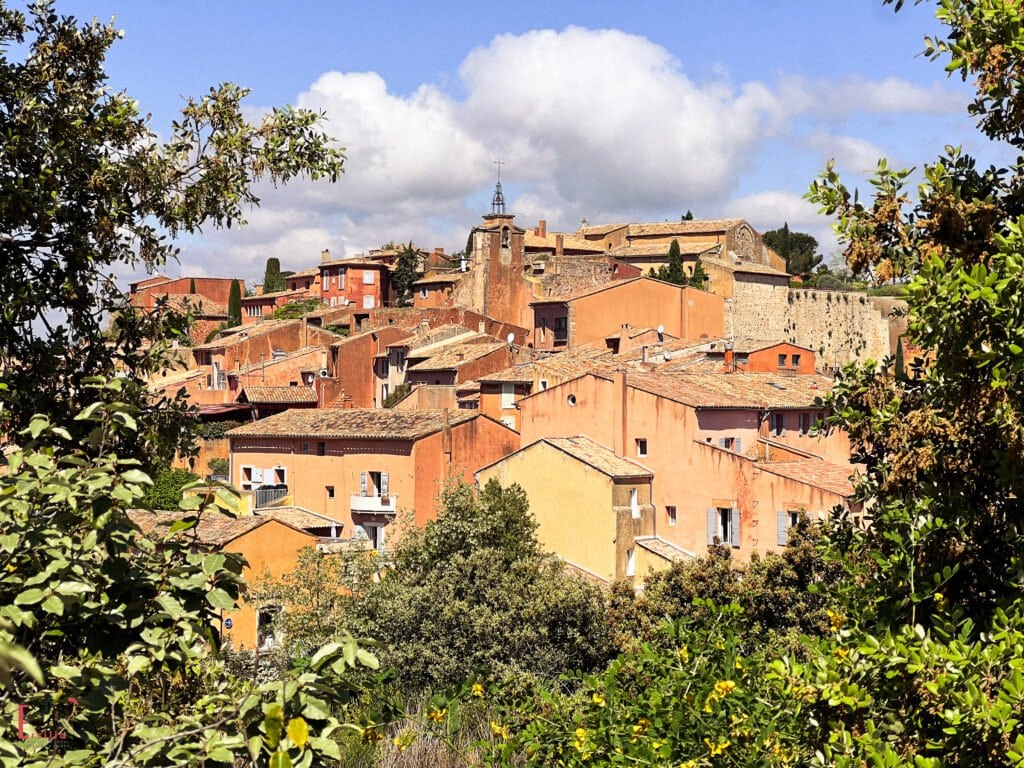
Arriving in Roussillon by mid-morning, I was immediately struck by the dramatic change in scenery. After the pale stone of Saignon, Roussillon’s buildings were all in warm ochre, orange, and red hues that seemed to capture and intensify the Provençal sunlight.
This village stands out not just in the Luberon but in all of France for its extraordinary color palette.
Known as the “Colorado of Provence,” Roussillon sits atop one of the world’s largest ochre deposits, which has influenced everything from the village architecture to the surrounding landscape.
The Ochre Cliffs and Sentier des Ocres
The highlight of Roussillon is undoubtedly the Sentier des Ocres (Ochre Trail), which I entered directly from the village. The €3.50 entry fee gave me access to a 30-60 minute walking circuit through an otherworldly landscape of sculpted ochre cliffs and formations.
Exploring the Village
After the trail, I wandered through Roussillon’s streets, where buildings in every shade of ochre created a harmonious village-wide palette. The Place de la Mairie offers a perfect spot to appreciate the architecture, with café terraces ideal for people-watching.
I especially loved the small art galleries scattered throughout the village. Roussillon has long attracted artists inspired by its colors, and several studios showcase work created with the local pigments.
I spent about 2.5 hours in Roussillon, which gave me enough time for both the ochre trail and village exploration. If you’re short on time, 1.5 hours would be sufficient for a more condensed visit.
Stop 3: Gordes – The Postcard-Perfect Hilltop Village
Driving time from Roussillon: About 20 minutes
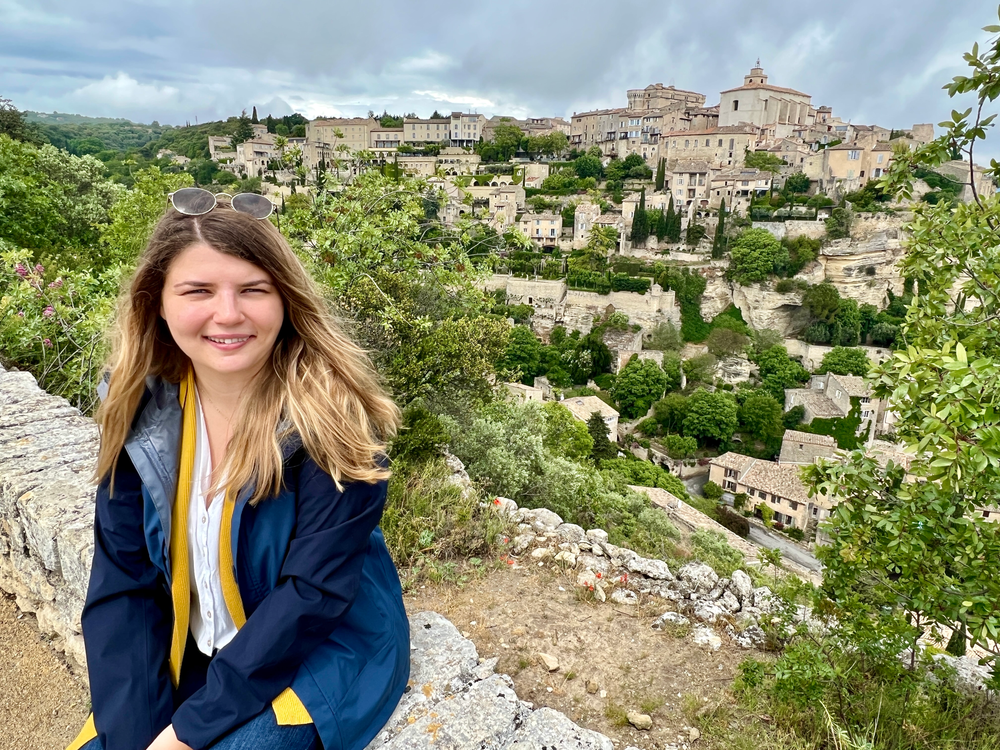
My afternoon began in Gordes, perhaps the most famous and photographed of all Luberon villages.
As I approached by car, the village appeared dramatically on its rocky outcrop, stone houses and ramparts seemingly growing out of the hillside itself.
This is the view that has launched a thousand postcards, and it’s worth pulling over at the viewpoint on the approach road to take it all in.
Unlike the warm hues of Roussillon, Gordes is built in limestone—pale, elegant, and imposing. It reminds me a bit of Italy. Its status as one of “Les Plus Beaux Villages de France” (The Most Beautiful Villages of France) is immediately apparent and well-deserved.
Exploring Gordes Village
I began in the central Place du Château, dominated by the impressive Renaissance castle (now housing a museum).
From this high point, narrow cobblestone streets wind downward in a labyrinth of stone buildings, archways, and terraces.
What struck me most about Gordes was how the entire village feels sculpted from a single piece of stone. The buildings blend seamlessly with the cliff face, creating a harmonious whole that speaks to centuries of architectural evolution.
As I wandered the streets, I discovered small squares with refreshing fountains, glimpses of the valley through narrow passages, and artisanal shops selling lavender products, Provençal textiles, and local art.
Don’t Miss in Gordes
If you have time, the Caves du Palais Saint-Firmin offer a fascinating glimpse into the underground levels of Gordes, where cellars, cisterns, and oil mills have been carved into the rock over centuries.
During lavender season (mid-June to early August), consider making a quick detour to the nearby Abbaye de Sénanque, where purple lavender fields against the stone abbey create one of Provence’s most iconic scenes. It’s just a 10-minute drive from the village and well worth the extra time.
Quick Refreshment
After exploring Gordes’ steep streets, I was ready for a break. The Cercle Républicain café on the main square offers the perfect vantage point for people-watching while enjoying a cold drink.
Their citron pressé (fresh lemonade) was exactly what I needed on a warm afternoon.
I allocated about 1.5 hours to Gordes, which was enough to explore the village center thoroughly. If you want to include attractions like the Caves du Palais Saint-Firmin or Sénanque Abbey, you’ll need additional time.
Stop 4: Ménerbes – Peter Mayle’s Provence
Driving time from Gordes: About 25 minutes
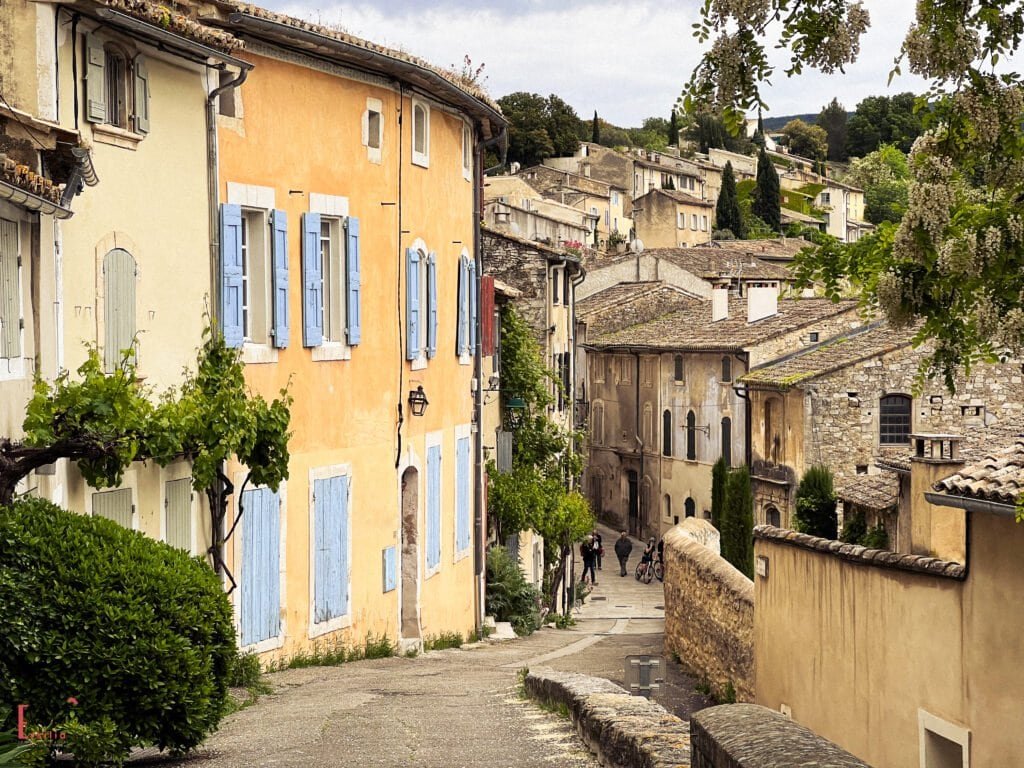
By mid-afternoon, I arrived in Ménerbes, a village made famous internationally by Peter Mayle’s book “A Year in Provence.” Despite its literary fame, Ménerbes retains a quieter, more laid-back atmosphere than some of its neighbors.
Stretching along a narrow ridge, Ménerbes offers beautiful views across vineyards and cherry orchards to the Luberon mountains beyond. The village’s elongated shape means you can walk from one end to the other in about 15 minutes, taking in changing perspectives as you go.
Highlights of Ménerbes
I started at the Place de l’Horloge, with its 16th-century bell tower and café terrace—the perfect spot to rest and absorb the village atmosphere. From there, I wandered to the northern edge of the village for spectacular views over the countryside.
The Maison de la Truffe et du Vin (House of Truffles and Wine) occupies a beautiful old building and offers tastings of local wines and truffle products. Even if you don’t go inside, the garden terrace provides one of the most beautiful viewpoints in the village.
A Sweet Break
After walking the length of the village, I treated myself to a pastry at La Maison de la Fontaine et du Patrimoine, where locals and visitors alike gather for coffee and conversation. Their tarte aux pommes perfectly complemented the late afternoon golden light washing over the stone buildings.
My visit to Ménerbes took about 1 hour, which allowed for a leisurely walk through the village and time to enjoy the views. Its compact size makes it easy to experience in a relatively short time.
Stop 5: Lacoste – In the Shadow of the Marquis
Driving time from Ménerbes: About 15 minutes
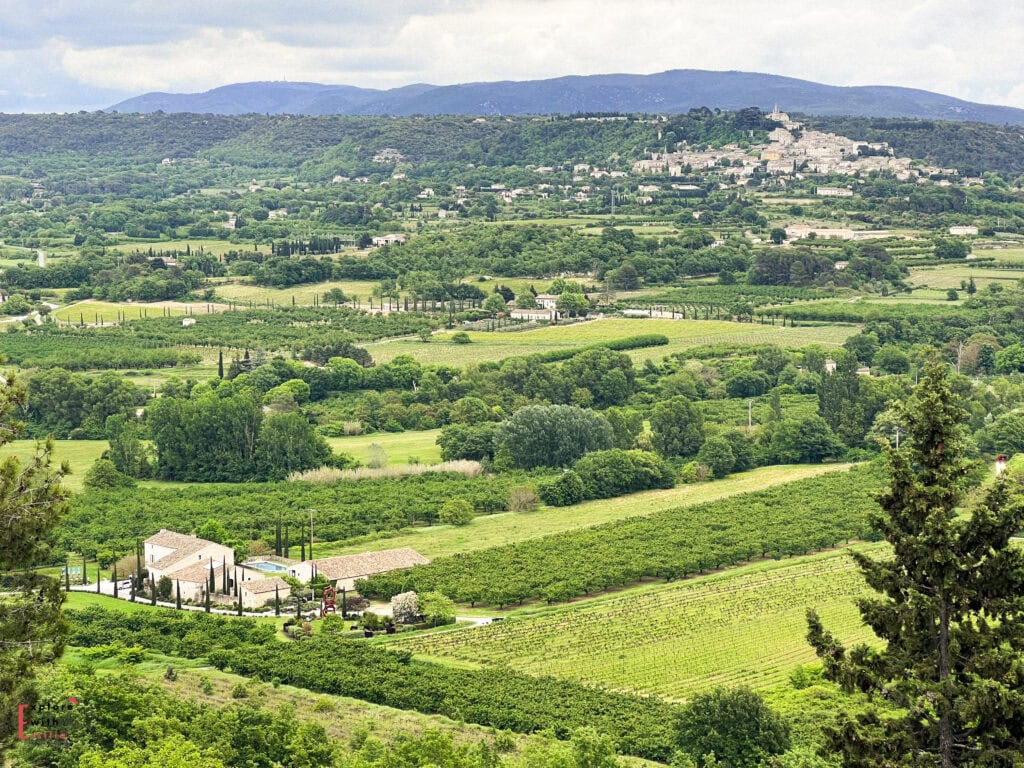
As the day began to wane, I reached my final destination: Lacoste.
Perhaps the most atmospheric of all the villages I visited, Lacoste is crowned by the ruins of the castle once owned by the infamous Marquis de Sade. Now owned by fashion designer Pierre Cardin, the restored ruins create a dramatic silhouette against the sky.
Lacoste has a wild, slightly untamed quality that sets it apart from its more manicured neighbors. Many buildings remain in a state of picturesque semi-ruin, stone facades standing sentinel as they have for centuries.
Exploring Lacoste Village
The approach to Lacoste involves a steep climb up cobblestone streets that wind toward the castle. This is definitely the most physically challenging village walk of the day, but the atmosphere more than compensates for the effort.
What makes Lacoste special is its authenticity—parts feel almost abandoned, while other areas have been carefully restored. This contrast creates a uniquely compelling environment that feels straight out of another century.
In summer, the village comes alive with students from the Savannah College of Art and Design (SCAD), which maintains a campus here. Their presence brings creative energy to the ancient stones, with exhibitions and performances adding a contemporary layer to the historical setting.
A Final Refreshment
After descending from the castle, I stopped at Café de France on the lower level of the village. Their terrace offered the perfect vantage point to reflect on the day’s adventures while watching the play of light and shadow across the valley as evening approached.
I spent about 1 hour in Lacoste, focusing mainly on the climb to the castle and the views. If you have more time, the village rewards unhurried exploration of its atmospheric corners.
Planning Your Own Five-Village Day Trip: Tips and Itinerary
Based on my experience, here’s a suggested timeline for your own village-hopping adventure:
- 8:00 AM: Depart Aix-en-Provence
- 9:30-10:30 AM: Explore Saignon
- 11:00 AM-1:30 PM: Visit Roussillon (including lunch)
- 2:00-3:30 PM: Discover Gordes
- 4:00-5:00 PM: Wander through Ménerbes
- 5:30-6:30 PM: Climb to Lacoste castle for sunset views
- 7:30 PM: Return to Aix-en-Provence
Best Time of Year
I did this trip in late May, which I found ideal—warm but not hot, flowers blooming, and villages lively but not overcrowded. Spring (April-June) and early fall (September-October) generally offer the best balance of good weather and manageable crowd levels.
July and August bring lavender blooms but also peak tourist crowds and intense heat. Winter offers a more authentic experience with few tourists, but some village businesses close for the season, and daylight hours are limited.
Making the Most of Your Time
To maximize your day:
- Start early to beat both crowds and heat
- Have breakfast before leaving Aix or bring something for the road
- Plan your lunch stop in advance (I recommend Roussillon)
- Keep water and snacks in the car
- Download offline maps, as cell service can be spotty
- Wear comfortable shoes—you’ll be walking on uneven cobblestones
Alternatives and Adaptations
If five villages feels too ambitious, consider dropping either Menerbres or Lacoste to create a more relaxed four-village itinerary.
Conversely, if you’re starting from Aix and have a full day, you could potentially add Bonnieux between Ménerbes and Lacoste.
Another option is to base yourself in the Luberon area for a night or two. The villages of Gordes and Roussillon both offer lovely accommodations, and staying locally would allow you to experience these places in the early morning or evening light when day-trippers have departed.
Here is a map comparing the best hotels and stays in the area !
Final Thoughts: The Magic of Provence’s Villages
My day exploring these five villages revealed something I couldn’t have understood by visiting just one: the remarkable diversity within the Luberon region.
From the ochre cliffs of Roussillon to the elegant stone of Gordes, from the authentic charm of Saignon to the wild beauty of Lacoste, each village offers its own interpretation of Provençal life.
What connects them all is a sense of harmony with the landscape, a reverence for history, and the unmistakable light that has drawn artists to Provence for centuries.
Whether you follow my exact route or create your own village-hopping adventure, this day trip offers a perfect introduction to the soul of Provence—one village at a time.
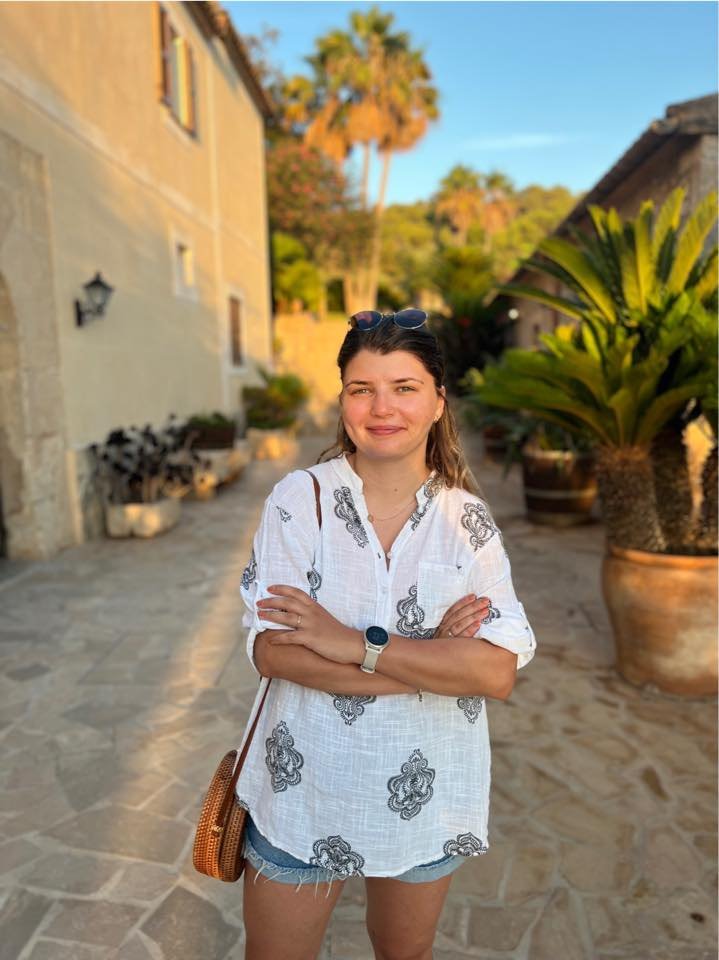
author page / EDITORIAL POLICY PAGE
Hi, I’m Ersilia

Toulouse, France

Originally from Romania

English & French Content
As a Romanian expat living in the heart of southern France, I guide English speakers to discover authentic French experiences without the language barrier. My unique perspective as both a local and an expat allows me to share insider tips, cultural insights, and practical advice that you won’t find in typical guidebooks.
My Expertise:
- French life and culture navigation
- Hidden gems across French regions
- Eastern vs Western European perspectives
- Local insights and practical travel tips
Blog Socials
Personal Pages







